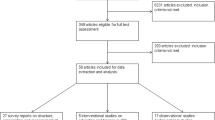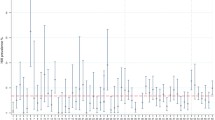Abstract
Objective
To evaluate compliance with recommended patient-care practices for the prevention of hospital-acquired infections (HAI) in the intensive care unit (ICU).
Design
European descriptive survey by questionnaire mailed to all the directors of ICUs.
Patients and participants
A total of 1642 general ICUs with more than three beds in 14 countries were contacted; 1005 units participated in the study (overall response rate of 61.2%).
Measurements and results
Data on the general characteristics of the hospital and of the ICU, surveillance activities, and patient-care practices relevant to the control of HAIs were collected. Compliance varied significantly by the type of practice evaluated. Comprehensive programs adopting all the recommended preventive practices for specific infections were maintained in a very low proportion of units, ranging from 18% for antibiotic policy to 39% for urinary tract infections. Moreover, 14% of the units claimed to adopt three or more practices that are clearly unsafe, and only 35% of the units claimed not to adopt any risky practice. The presence of an infection control nurse was significantly associated with a lower frequency of substandard care. A great variability was observed by country in the adoption of 29 patient-care practices, mostly for practices for which clear-cut guidelines are lacking.
Conclusion
Interpretation of data is made difficult by the lack of consensus among experts with respect to some of the practices investigated. Nevertheless, the implementation of standard practices for preventing HAIs is far from satisfactory in the hospitals surveyed, even in a high priority hospital area such as intensive care. Documented European guidelines could be worth-while in increasing awareness of the ICU staff. The availability of at least one infection control nurse in each hospital should be strongly advocated.
Similar content being viewed by others
References
Craven D, Steger KA, Barber TW (1991) Preventing nosocomial pneumonia: state of the art and perspectives for the 1990s. Am J Med 91 [Suppl 3B]: 44S-53S
Nichols RL (1991) Surgical wound infections. Am J Med 91 [Suppl 3B]: 54S-64S
Stamm WE (1991) Catheter-associated urinary tract infections: epidemiology, pathogenesis and prevention. Am J Med 91 [Suppl 3B]: 65S-71S
Maki DG (1989) Pathogenesis, prevention and management of infections due to intravascular devices used for infusion therapy. In: Bisno Al, Waldvogel FA (eds). Infections associated with indwelling medical devices. American Society for Microbiology, Washington, DC, pp 161–177
Weinstein RA (1991) Epidemiology and control of nosocomial infections in adult intensive care units. Am J Med 91 [Suppl 3B]: 179S-184S
Centers for Disease Control (1981) Guidelines for prevention and control of nosocomial infections. US Department of Health and Human Services, Centers for Disease Control, Atlanta, GA
Centers for Disease Control (1986) Guidelines for handwashing and hospital environmental control. Am J Infect Control 14: 110–129
Centers for Disease Control (1986) Guidelines for prevention of surgical wound infections. Am J Infect Control 14: 71–80
Anonymous (1988) Resource list for standards and guidelines related to infection control practice. Am J Infect Control 16: 38A–43A
Ducel G, Haxhe JJ, Tanner F, Zumofen M (1979) Practical guide to the prevention of hospital-acquried infections. World Health Organization, Geneva
Celentano DD, Morlock LL, Malitz FE (1987) Diffusion and adoption of CDC guidelines for the prevention and control of nosocomial infections in US hospitals. Infect Control 8: 415–423
Haley RW, Culver DH, White JW, Morgan WM, Emori TG, Munn VP, Hooton TM (1985) The efficacy of infection surveillance and control programs in preventing nosocomial infections in US hospitals. Am J Epidemiol 121: 182–205
Wenzel RP, Thompson RL, Landry SM, Russel BS, Miller PJ, Ponce de Leon S, Miller GB Jr. (1983) Hospital-acquired infections in intensive care unit patients: an overview with emphasis on epidemics. Infect Control 4: 371–375
Donowitz LG, Wenzel RP, Hoyt JW (1982) High risk of hospital-acquired infection on the ICU patient. Crit Care Med 10: 355–357
Daschner FD, Frey P, Wolff G, Baumann PC, Suter P (1982) Nosocomial infections in intensive care wards. A multicenter prospective study. Intensive Care Med 8: 5–9
Chevret S, Hemmer M, Carlet J, Langer M and the European Cooperative Group on Nosocomial Pneumonia (1993) Incidence and risk factors of pneumonia in intensive care units. Intensive Care Med 19: 256–264
Inglis L (1992) Infection control in intensive care units: UK National Survey. Br J Anaesth 68: 216–220
Norusis MJ (1986) SPSS/PC for the IBM PC/XT/AT. SPSS, Chicago, IL
Armitage P (1973) Statistical methods in medical research. Blackwell Scientific, Oxford, pp 34–43
Williamson DF, Parker RA, Kendrick JS (1989) The box plot: a simple visual method to interpret data. Ann Intern Med 110: 916–921
Craven DE, Connolly MG, Lichtenberg DA, Primeau PJ, McCabe WR (1982) Contamination of mechanical ventilators with tubing changes every 24 or 48 hours. N Engl J Med 306: 1505–1509
Maki DG, Botticelli JT, Thielke TS (1987) Prospective study of replacing administration sets for intravenous therapy at 48- vs 72 hour intervals. 72 hours is safe and cost-effective. JAMA 258: 1777–1781
Eisenberg JM (1985) Physician utilization. The state of research about physicians' practice pattern. Med Care 23: 461–483
McLaughlin AJ (1983) Manual of infection control in respiratory care. Little, Brown, Boston, MA, pp 91–92
Palmer MB (1984) Infection control. A policy and procedure manual. Saunders, Philadelphia, PA, pp 125–126
Maki DG, Ringer M, Alvarado CJ (1991) Prospective randomised trial of povidone-iodine, alcohol, and chlorhexidine for prevention of infection associated with central venous and arterial catheters. Lancet 338: 339–343
Burke JP, Garibaldi RA, Britt MR, Jacobson MA, Conti M, Alling DW (1981) Prevention of catheter-associated urinary tract infections. Efficacy of daily meatal care regimens. Am J Med 70: 655–658
Classen DC, Larsen RA, Burke JP, Alling DW, Stevens LE (1991) Daily meatal care for prevention of catheter-associated bacteriuria: results using frequent applications of polyantibiotic cream. Infect Control Hosp Epidemiol 12: 157–162
Author information
Authors and Affiliations
Consortia
Additional information
This study was carried out within the European Research Project “EURO.NIS: Nosocomial Infections in Intensive Care Units in Europe” sponsored by the European Economic Community
Rights and permissions
About this article
Cite this article
Moro, M.L., Jepsen, O.B. & The EURO.NIS Study Group. Infection control practices in intensive care units of 14 European countries. Intensive Care Med 22, 872–879 (1996). https://doi.org/10.1007/BF02044110
Received:
Accepted:
Issue Date:
DOI: https://doi.org/10.1007/BF02044110




